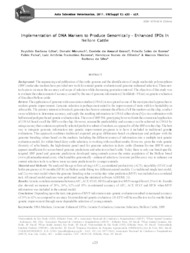Implementation of DNA markers to produce genomically enhanced EPDs in Nellore cattle.
Implementation of DNA markers to produce genomically enhanced EPDs in Nellore cattle.
Autoria: LÔBO, R. B.; NKRUMAH, D.; GROSSI, D. do A.; BARROS, P. S. de; PAIVA, P.; BEZERRA, L. A. F.; OLIVEIRA, H. N. de; SILVA, M. V. G. B.
Resumo: Background: The sequencing and publication of the cattle genome and the identification of single nucleotide polymorphism (SNP) molecular markers have provided new tools for animal genetic evaluation and genomic-enhanced selection. These new tools aim to increase the accuracy and scope of selection while decreasing generation interval. The objective of this study was to evaluate the enhancement of accuracy caused by the use of genomic information (Clarifide® - Pfizer) on genetic evaluation of Brazilian Nellore cattle. Review: The application of genome-wide association studies (GWAS) is recognized as one of the most practical approaches to modern genetic improvement. Genomic selection is perhaps most suited to the improvement of traits with low heritability in zebu cattle. The primary interest in livestock genomics has been to estimate the effects of all the markers on the chip, conduct cross-validation to determine accuracy, and apply the resulting information in GWAS either alone [9] or in combination with bull test and pedigree-based genetic evaluation data. The cost of SNP50K genotyping however limits the commercial application of GWAS based on all the SNPs on the chip. However, reasonable predictability and accuracy can be achieved in GWAS by using an assay that contains an optimally selected predictive subset of markers, as opposed to all the SNPs on the chip. The best way to integrate genomic information into genetic improvement programs is to have it included in traditional genetic evaluations. This approach combines traditional expected progeny differences based on phenotype and pedigree with the genomic breeding values based on the markers. Including the different sources of information into a multiple trait genetic evaluation model, for within breed dairy cattle selection, is working with excellent results. However, given the wide genetic diversity of zebu breeds, the high-density panel used for genomic selection in dairy cattle (Ilumina Bovine SNP50 array) appears insufficient for across-breed genomic predictions and selection in beef cattle. Today there is only one breed-specific targeted SNP panel and genomic predictions developed using animals across the entire population of the Nellore breed (http://www.pfizersaudeanimal.com), which enables genomically - enhanced selection. Genomic profiles are a way to enhance our current selection tools to achieve more accurate predictions for younger animals. Material and Methods: We analyzed the age at first calving (AFC), accumulated productivity (ACP), stayability (STAY) and heifer pregnancy at 30 months (HP30) in Nellore cattle fitting two different animal models; 1) a traditional single trait model, and 2) a two-trait model where the genomic breeding value or molecular value prediction (MVP) was included as a correlated trait. All mixed model analyses were performed using the statistical software ASREML 3.0. Results: Genetic correlation estimates between AFC, ACP, STAY, HP30 and respective MVPs ranged from 0.29 to 0.46. Results also showed an increase of 56%, 36%, 62% and 19% in estimated accuracy of AFC, ACP, STAY and HP30 when MVP information was included in the animal model. Conclusion: Depending upon the trait, integration of MVP information into genetic evaluation resulted in increased accuracy of 19% to 62% as compared to accuracy from traditional genetic evaluation. GE-EPD will be an effective tool to enable faster genetic improvement through more dependable selection of young animals.
Ano de publicação: 2011
Tipo de publicação: Artigo de periódico
Unidade: Embrapa Gado de Leite
Palavras-chave: DNA Markers, Genetic Evaluation, Genomic Enhanced EPDs, Genomic Selection, Nellore Cattle, SNP
Observações
1 - Por padrão são exibidas publicações dos últimos 20 anos. Para encontrar publicações mais antigas, configure o filtro ano de publicação, colocando o ano a partir do qual você deseja encontrar publicações. O filtro está na coluna da esquerda na busca acima.
2 - Para ler algumas publicações da Embrapa (apenas as que estão em formato ePub), é necessário ter, no celular ou computador, um desses softwares gratuitos. Sistemas Android: Google Play Livros; IOS: iBooks; Windows e Linux: software Calibre.
Acesse outras publicações
Acesse a Base de Dados da Pesquisa Agropecuária (BDPA) para consultar o acervo completo das bibliotecas da Embrapa.

